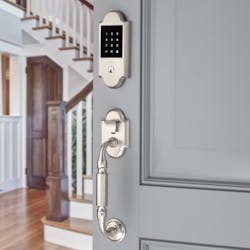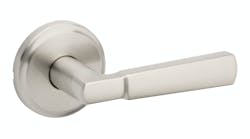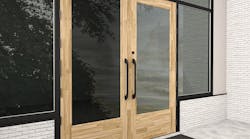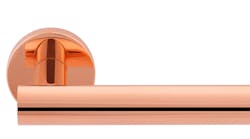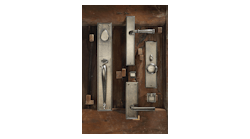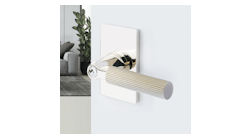This is the day of high-tech gadgetry. A huge percentage of homeowners and amall to midsize businesses (SMBs) are aggressively focused on obtaining as much hard tech as possible. This potentially provides them with a higher level of convenience and security than would otherwise be available using older mechanical locks. In addition, it enables them to more easily manage access by way of software.
One area where the drive to high-tech solutions is extremely pronounced is that of electronic keyless entry in combination with otherwise ordinary decorative door hardware. According to Parks Associates, Addison, TX , the popularity of connected smart locks will expand in the next few years from early adopters to households with moderate incomes and smaller homes.
Smart locks are internet-connected devices designed to be controlled through a mobile device App as well as a voice command solution, such as Amazon Alexa or Google Assistant (Smart locks: One in four households intend to buy this year, http://bit.ly/2sAOrHy). This is only part of the story because these same locks can be connected with mobile tech through other wireless means right at the door, thus reducing the likelihood of data interception from criminals remote from the user’s location.
All Aboard the High-Tech Lock Train
There’s a good reason why you, as a prominent locksmith in your hometown, should embrace the high-tech changes occurring in door locking hardware. Besides the need for better security, which electronic locking devices provide, there’s the matter of money.
“Adoption of smart door locks continues to increase, with annual unit sales projected to increase by more than 75% from 2017 to 2021,” said Brad Russell, Research Analyst, Parks Associates. “The increase in adoption will lead to a $150 million increase in annual sales revenues during that period” (http://bit.ly/2EfEaTY)
In this exclusive Locksmith Ledger article, we’ll dive into the state of today’s smart decorative lock. We’ll end with a look at five different manufacturers and their uniquely different approaches to this entry-solution effort.
Traditional Vs Decorative Locking Solutions
A traditional keyless entry solution differs from a decorative one primarily in outward appearance. Decorative solutions often involve the subtle use of technology, adding a module on the inside of the door, for example. In this case the module maintains the use of the mechanical lock, but with added features brought by electronics and a motorized gear assembly within.
Traditional, on the other hand, often involves the replacement of the original lock assembly with a new one that has a keypad and/or card reader on the outer face of the door. There’s also a blending of the two available where the reader portion is installed on the outer face of the door, but in a style consistent with the outer appearance of the decorative hardware itself.
Both solutions can, and often do leverage the use of high-tech electronics--including wireless--to control what is otherwise a simple mechanical lock. The latter method often is achieved by adding a motorized, electronics module with a common thumb turn--in place of the original inside hardware.
Basic Features
Most of the locking systems on the market today look as though their makers added a high-tech component after the fact, and in some cases, that may be true. Regardless whether lock and electronics were released to the marketplace separately or at the same time is irrelevant simply because the overall capabilities built into these locks are virtually identical. Let’s chat about some of them before looking at specific makes and models.
As a side note, some of the makes and models available are Grade 1, others are Grade 2, so you need to know which one to buy.
Electronic locks have the ability to accept tens and even hundreds of separate users, whether it involves individual PINs (Personal Identification Numbers), keyfobs, or some kind of card. Some makes and models, however, also contain a key override, which can be used when the lock fails, as when the internal batteries die.
There are three good reasons why we’re able to get away without running cable.
- These locks are battery operated, AAA or 9V in some cases
- They are often wirelessly connected to other devices
- The keypad and/or card readers involved are contained on the door itself
As mentioned earlier, through a built-in sensor, the position and the lock/unlock condition of the door can be transmitted to a centralized access control system as well as individual mobile devices. Network connectivity is usually provided by WiFi (802.11). In most instances, you can, if you so wish, connect these locks to a computer network using Ethernet wiring -- something that most of us will not want to do.
How to Sell High-Tech Decorative Locks
First, you must know your audience. Who are you most likely to sell these items to? Homeowners or business owners? Perhaps both? Second, what are the needs and wants of your audience?
In order to sell anything, you have to be able to solve a need. [email protected] . In most cases, business owners are looking for the same things. And they’re willing to pay for it. Someone will walk away with the money eventually and it may as well be you!
In a residential application, the homeowner’s electronic decorator smart lock can be synchronized with his mobile device -- usually a smartphone. One particular make/model of lock is able to connect with each user’s smartphone using both WiFi and Bluetooth, enabling it to know the approximate location of the end user in relation to the home or SMB.
For example, when an authorized user leaves the home, the locking system knows it, thus locking the door automatically. Upon return, the lock is aware of the end user’s presence, but will only automatically unlock the door when they are within Bluetooth distance. WiFi enables these locks to know when the homeowner is approaching and Bluetooth tells it when to lock or unlock.
There are advantages to this type of tech even for businesses as you can well imagine. When combined with cameras, it’s possible for the end user to actually converse with someone at the door when a door or doorbell camera is installed. Lock control is possible through a variety of mobile Apps, such as Apple HomeKit, Apple TV, HomePod, and others, in addition to voice commands.
There are five manufacturers that assisted in the writing of this story. They are:
- Baldwin
- EMTEK by ASSA ABLOY
- Kwikset
- Marks USA
- Yale by ASSA ABLOY
Baldwin offers the Evolved (http://bit.ly/35PCbBP) and TouchScreen (http://bit.ly/35Rc79d) lines of electronic decorator locks. Where the former uses a subtle approach, placing the technology on the inside of the door, the latter offers an attractive soft keypad using what Baldwin calls their SecureScreen tech. “Simply activate the screen with your palm or the back of the hand and enter a four- to eight-digit code for easy unlocking,” says Baldwin.
EMTEK by ASSA ABLOY offers the EMPoweredTM Smart Lock Upgrade (http://bit.ly/377Q2DT) as an electronic add-on to their new EMTEK decorator keyed products. This line offers “The convenience of smart technology without any hint of gadgetry,” says EMTEK. This manufacturer also offers the EMPoweredTM Motorized Touchscreen Keypad Lock (http://bit.ly/35NN9rm).
Kwikset, a well known lock in our industry, has also responded to the need for electronic decorator locks. The Premis Touchscreen Smart Lock (http://bit.ly/2ZgZt0L) features the use of “Apple HomeKit technology for smarter home management.” Lock monitoring, the use of Siri verbal commands, remote mobile device control, and advanced user code management distinguish this electronic lock solution from its older mechanical wares.
Marks USA, which is a subsidiary of Napco Security Technologies, also offers a host of electronic lock solutions. In this case, the ArchiTech Enterprise Solution (http://bit.ly/36TIjJo), is used to integrate door security with access control, alarm, and video surveillance systems. This is an ideal solution for educational facilities, commercial offices, multi-family commercial buildings, and single-family homes. Integration can take place using Continental Access CA4K, Lenel OnGuard, or Marks’ Software House Connected Program.
Yale, another well known name in electronic locking hardware, offers two decorator electronic locking solutions. The nexTouch is a Grade 1 Certified Keypad Lock (http://bit.ly/34KiSZ7). It fits into a standard mortise door prep and it accepts a conventional, interchangeable core with security and high security cylinders. It features an electronic touchscreen or pushbutton keypad and it complies with ADA requirements. Up to 500 user codes in keypad mode and the modular construction associated with this lock solution enables the user to upgrade to data-on-card or wireless applications using mobile devices.
If you have questions concerning this story, ask the author via email at [email protected].
